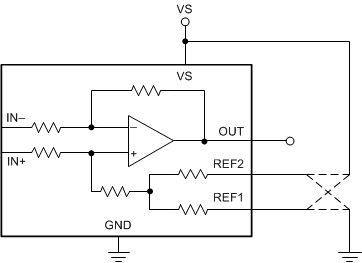SBOS956 December 2018 INA240-SEP
PRODUCTION DATA.
- 1 Features
- 2 Applications
- 3 Description
- 4 Revision History
- 5 Pin Configuration and Functions
- 6 Specifications
-
7 Detailed Description
- 7.1 Overview
- 7.2 Functional Block Diagram
- 7.3 Feature Description
- 7.4 Device Functional Modes
- 8 Application and Implementation
- 9 Power Supply Recommendations
- 10Layout
- 11Device and Documentation Support
- 12Mechanical, Packaging, and Orderable Information
Package Options
Mechanical Data (Package|Pins)
- PW|8
Thermal pad, mechanical data (Package|Pins)
Orderable Information
7.4.1 Adjusting the Output Midpoint With the Reference Pins
Figure 22 shows a test circuit for reference-divider accuracy. The INA240-SEP output is configurable to allow for unidirectional or bidirectional operation.
 Figure 22. Test Circuit For Reference Divider Accuracy
Figure 22. Test Circuit For Reference Divider Accuracy NOTE
Do not connect the REF1 pin or the REF2 pin to any voltage source lower than GND or higher than VS.
The output voltage is set by applying a voltage or voltages to the reference voltage inputs, REF1 and REF2. The reference inputs are connected to an internal gain network. There is no operational difference between the two reference pins.